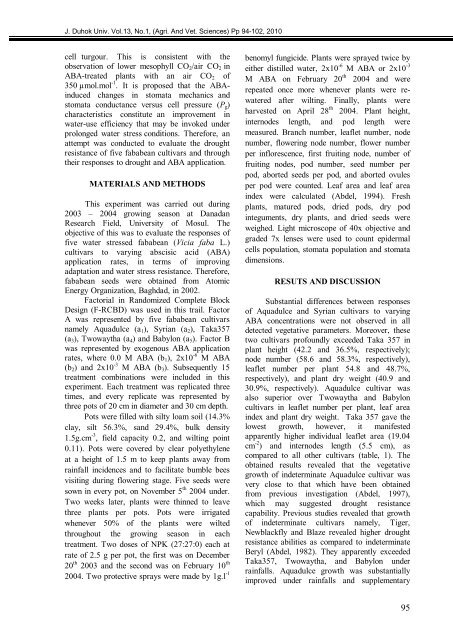The Influence Of Priming Two Cucumber Cultivar Seeds
The Influence Of Priming Two Cucumber Cultivar Seeds
The Influence Of Priming Two Cucumber Cultivar Seeds
You also want an ePaper? Increase the reach of your titles
YUMPU automatically turns print PDFs into web optimized ePapers that Google loves.
J. Duhok Univ. Vol.13, No.1, (Agri. And Vet. Sciences) Pp 94-102, 2010<br />
cell turgour. This is consistent with the<br />
observation of lower mesophyll CO2/air CO2 in<br />
ABA-treated plants with an air CO2 of<br />
350 µmol.mol -1 . It is proposed that the ABAinduced<br />
changes in stomata mechanics and<br />
stomata conductance versus cell pressure (Pg)<br />
characteristics constitute an improvement in<br />
water-use efficiency that may be invoked under<br />
prolonged water stress conditions. <strong>The</strong>refore, an<br />
attempt was conducted to evaluate the drought<br />
resistance of five fababean cultivars and through<br />
their responses to drought and ABA application.<br />
MATERIALS AND METHODS<br />
This experiment was carried out during<br />
2003 – 2004 growing season at Danadan<br />
Research Field, University of Mosul. <strong>The</strong><br />
objective of this was to evaluate the responses of<br />
five water stressed fababean (Vicia faba L.)<br />
cultivars to varying abscisic acid (ABA)<br />
application rates, in terms of improving<br />
adaptation and water stress resistance. <strong>The</strong>refore,<br />
fababean seeds were obtained from Atomic<br />
Energy Organization, Baghdad, in 2002.<br />
Factorial in Randomized Complete Block<br />
Design (F-RCBD) was used in this trail. Factor<br />
A was represented by five fababean cultivars<br />
namely Aquadulce (a1), Syrian (a2), Taka357<br />
(a3), <strong>Two</strong>waytha (a4) and Babylon (a5). Factor B<br />
was represented by exogenous ABA application<br />
rates, where 0.0 M ABA (b1), 2x10 -6 M ABA<br />
(b2) and 2x10 -3 M ABA (b3). Subsequently 15<br />
treatment combinations were included in this<br />
experiment. Each treatment was replicated three<br />
times, and every replicate was represented by<br />
three pots of 20 cm in diameter and 30 cm depth.<br />
Pots were filled with silty loam soil (14.3%<br />
clay, silt 56.3%, sand 29.4%, bulk density<br />
1.5g.cm -3 , field capacity 0.2, and wilting point<br />
0.11). Pots were covered by clear polyethylene<br />
at a height of 1.5 m to keep plants away from<br />
rainfall incidences and to facilitate bumble bees<br />
visiting during flowering stage. Five seeds were<br />
sown in every pot, on November 5 th 2004 under.<br />
<strong>Two</strong> weeks later, plants were thinned to leave<br />
three plants per pots. Pots were irrigated<br />
whenever 50% of the plants were wilted<br />
throughout the growing season in each<br />
treatment. <strong>Two</strong> doses of NPK (27:27:0) each at<br />
rate of 2.5 g per pot, the first was on December<br />
20 th 2003 and the second was on February 10 th<br />
2004. <strong>Two</strong> protective sprays were made by 1g.l -1<br />
benomyl fungicide. Plants were sprayed twice by<br />
either distilled water, 2x10 -6 M ABA or 2x10 -3<br />
M ABA on February 20 th 2004 and were<br />
repeated once more whenever plants were rewatered<br />
after wilting. Finally, plants were<br />
harvested on April 28 th 2004. Plant height,<br />
internodes length, and pod length were<br />
measured. Branch number, leaflet number, node<br />
number, flowering node number, flower number<br />
per inflorescence, first fruiting node, number of<br />
fruiting nodes, pod number, seed number per<br />
pod, aborted seeds per pod, and aborted ovules<br />
per pod were counted. Leaf area and leaf area<br />
index were calculated (Abdel, 1994). Fresh<br />
plants, matured pods, dried pods, dry pod<br />
integuments, dry plants, and dried seeds were<br />
weighed. Light microscope of 40x objective and<br />
graded 7x lenses were used to count epidermal<br />
cells population, stomata population and stomata<br />
dimensions.<br />
RESUTS AND DISCUSSION<br />
Substantial differences between responses<br />
of Aquadulce and Syrian cultivars to varying<br />
ABA concentrations were not observed in all<br />
detected vegetative parameters. Moreover, these<br />
two cultivars profoundly exceeded Taka 357 in<br />
plant height (42.2 and 36.5%, respectively);<br />
node number (58.6 and 58.3%, respectively),<br />
leaflet number per plant 54.8 and 48.7%,<br />
respectively), and plant dry weight (40.9 and<br />
30.9%, respectively). Aquadulce cultivar was<br />
also superior over <strong>Two</strong>waytha and Babylon<br />
cultivars in leaflet number per plant, leaf area<br />
index and plant dry weight. Taka 357 gave the<br />
lowest growth, however, it manifested<br />
apparently higher individual leaflet area (19.04<br />
cm -2 ) and internodes length (5.5 cm), as<br />
compared to all other cultivars (table, 1). <strong>The</strong><br />
obtained results revealed that the vegetative<br />
growth of indeterminate Aquadulce cultivar was<br />
very close to that which have been obtained<br />
from previous investigation (Abdel, 1997),<br />
which may suggested drought resistance<br />
capability. Previous studies revealed that growth<br />
of indeterminate cultivars namely, Tiger,<br />
Newblackfly and Blaze revealed higher drought<br />
resistance abilities as compared to indeterminate<br />
Beryl (Abdel, 1982). <strong>The</strong>y apparently exceeded<br />
Taka357, <strong>Two</strong>waytha, and Babylon under<br />
rainfalls. Aquadulce growth was substantially<br />
improved under rainfalls and supplementary<br />
49



